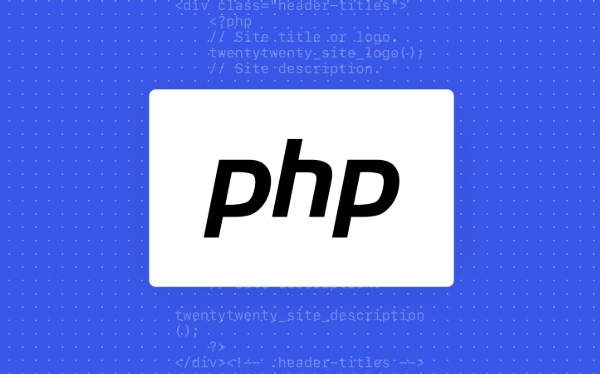How to use PHP sessions without cookies?
Jul 09, 2025 am 02:55 AMThere are two main ways to run a PHP session without cookies by manually passing the session ID. First, enable URL session ID propagation, and enable PHP to automatically attach the session ID to the link by setting session.use_cookies=0, session.use_only_cookies=0 and session.use_trans_sid=1 in php.ini; second, manually process the session ID, obtain it through session_id() and explicitly pass it in the link or form, and read the ID to restore the session on the subsequent page. Pay attention to security risks such as session fixation, historical leakage and caching issues. Session_regenerate_id() should be used, avoid publicly exposing IDs, and give priority to using cookies with the HttpOnly/Secure flag.

You can use PHP sessions without cookies by passing the session ID manually through URLs or other methods. The default behavior for PHP sessions is to store a session ID in a cookie, but if you need to support environments where cookies are disabled or blocked, there are alternative approaches.

Here's how you can make it work effectively.
How PHP Sessions Normally Work
By default, when you start a session using session_start() , PHP creates a unique session ID and stores it in a cookie on the user's browser. That session ID is then sent back to the server with each request so PHP can retrieve the correct session data.

But what happens if cookies aren't available? PHP still generates a session ID, but it won't be automatically passed between requests. So you have to pass it yourself — typically via the URL or hidden form fields.
Enabling Session IDs in URLs
PHP has built-in support for appending the session ID to URLs. This feature is controlled by two settings in your php.ini file:

-
session.use_cookies– controls whether PHP sends the session ID using cookies. -
session.use_only_cookies– tells PHP to only use cookies for session IDs (disable this). -
session.use_trans_sid– enables transparent session ID propagation via URLs.
To enable session IDs in URLs, set these values ??like this:
session.use_cookies = 0 session.use_only_cookies = 0 session.use_trans_sid = 1
Once configured, PHP will automatically append the session ID to any internal links that are properly formatted. For example:
<?php session_start(); ?> <a href="page.php">Go to page</a>
The generated link might look like this:
page.php?PHPSESSID=abc123xyz
?? Important: Only use this method if absolutely necessary. Passing session IDs in URLs can expose them in referrer headers and browser history, which poses security risks.
Manually Handling Session IDs
If you want more control over how the session ID is passed, you can handle it manually. Here's how:
Start the session as usual:
session_start();
Get the session ID:
$sid = session_id();
Append it to links or forms:
echo '<a href="next_page.php?sid=' . $sid . '">Continue</a>';
On the next page, read the session ID from the URL and resume the session:
if (isset($_GET['sid'])) { session_id($_GET['sid']); } session_start();This approach gives you full control and avoids relying on PHP's automatic behavior. You can also pass the session ID via POST requests or JavaScript variables if needed.
Security Considerations
Passing session IDs via URLs introduces some security concerns:
- Session fixation : If someone guesses or captures a session ID, they can impersonate the user.
- History leak : Browsers store URLs with session IDs in history, logs, and referrer headers.
- Caching issues : URLs with session IDs may get cached by proxies or browsers.
To mitigate these risks:
- Always regenerate the session ID after login using
session_regenerate_id(). - Avoid exposing session IDs publicly.
- Prefer cookies when possible, since they offer better security options (like
HttpOnlyandSecureflags).
Summary
Using PHP sessions without cookies is doable but requires careful handling. You can either rely on PHP's built-in transparent SID support or manage the session ID manually via URLs or form fields. Just remember that while this method works in restricted environments, it comes with trade-offs in terms of security and usability.
Basically that's it.
The above is the detailed content of How to use PHP sessions without cookies?. For more information, please follow other related articles on the PHP Chinese website!

Hot AI Tools

Undress AI Tool
Undress images for free

Undresser.AI Undress
AI-powered app for creating realistic nude photos

AI Clothes Remover
Online AI tool for removing clothes from photos.

Clothoff.io
AI clothes remover

Video Face Swap
Swap faces in any video effortlessly with our completely free AI face swap tool!

Hot Article

Hot Tools

Notepad++7.3.1
Easy-to-use and free code editor

SublimeText3 Chinese version
Chinese version, very easy to use

Zend Studio 13.0.1
Powerful PHP integrated development environment

Dreamweaver CS6
Visual web development tools

SublimeText3 Mac version
God-level code editing software (SublimeText3)

Hot Topics
 How to check if PHP session has been started?
Aug 28, 2023 pm 09:25 PM
How to check if PHP session has been started?
Aug 28, 2023 pm 09:25 PM
In PHP, we use the built-in function session_start() to start a session. But the problem we have with the PHP script is that if we execute it more than once, it throws an error. So, here we will learn how to check if the session has been started without calling the session_start() function twice. There are two ways to solve this problem. For PHP5.4.0 and below. Example<?php if(session_id()==''){
 Are there any alternatives to PHP sessions?
Apr 29, 2025 am 12:36 AM
Are there any alternatives to PHP sessions?
Apr 29, 2025 am 12:36 AM
Alternatives to PHP sessions include Cookies, Token-based Authentication, Database-based Sessions, and Redis/Memcached. 1.Cookies manage sessions by storing data on the client, which is simple but low in security. 2.Token-based Authentication uses tokens to verify users, which is highly secure but requires additional logic. 3.Database-basedSessions stores data in the database, which has good scalability but may affect performance. 4. Redis/Memcached uses distributed cache to improve performance and scalability, but requires additional matching
 How to handle PHP session expiration errors and generate corresponding error messages
Aug 08, 2023 pm 02:18 PM
How to handle PHP session expiration errors and generate corresponding error messages
Aug 08, 2023 pm 02:18 PM
How to handle PHP session expiration errors and generate corresponding error messages. When developing with PHP, it is very important to handle session expiration errors, because session expiration will cause users to be forced to exit when performing some sensitive operations, and will also bring problems to users. Bad experience. This article will introduce how to handle PHP session expiration errors and generate corresponding error messages to help developers better handle this situation. In PHP, session expiration is mainly determined by the session timeout. When a session exceeds the set timeout,
 Methods to solve PHP session failure errors and generate corresponding error prompts
Aug 07, 2023 am 09:48 AM
Methods to solve PHP session failure errors and generate corresponding error prompts
Aug 07, 2023 am 09:48 AM
Methods to solve PHP session invalidation errors and generate corresponding error prompts. When developing PHP applications, Session is a mechanism used to track and store user data. It can store important information such as the user's login status, shopping cart contents, etc. However, when using sessions, we sometimes encounter the problem of session invalidation, which will cause the user's data to be lost, and even cause the application functions to not function properly. This article will introduce how to solve the PHP session failure error and generate the corresponding error message. Check session timeout
 What are some common problems that can cause PHP sessions to fail?
Apr 25, 2025 am 12:16 AM
What are some common problems that can cause PHP sessions to fail?
Apr 25, 2025 am 12:16 AM
Reasons for PHPSession failure include configuration errors, cookie issues, and session expiration. 1. Configuration error: Check and set the correct session.save_path. 2.Cookie problem: Make sure the cookie is set correctly. 3.Session expires: Adjust session.gc_maxlifetime value to extend session time.
 What is the main purpose of using sessions in PHP?
Apr 22, 2025 pm 05:25 PM
What is the main purpose of using sessions in PHP?
Apr 22, 2025 pm 05:25 PM
The main purpose of using sessions in PHP is to maintain the status of the user between different pages. 1) The session is started through the session_start() function, creating a unique session ID and storing it in the user cookie. 2) Session data is saved on the server, allowing data to be passed between different requests, such as login status and shopping cart content.
 What steps would you take if sessions aren't working on your server?
May 03, 2025 am 12:19 AM
What steps would you take if sessions aren't working on your server?
May 03, 2025 am 12:19 AM
The server session failure can be solved through the following steps: 1. Check the server configuration to ensure that the session is set correctly. 2. Verify client cookies, confirm that the browser supports it and send it correctly. 3. Check session storage services, such as Redis, to ensure that they are running normally. 4. Review the application code to ensure the correct session logic. Through these steps, conversation problems can be effectively diagnosed and repaired and user experience can be improved.
 Methods to solve PHP session concurrency limit error and generate corresponding error prompts
Aug 06, 2023 pm 09:17 PM
Methods to solve PHP session concurrency limit error and generate corresponding error prompts
Aug 06, 2023 pm 09:17 PM
Methods to solve PHP session concurrency limit error and generate corresponding error prompts. In PHP development, session (Session) is a very important concept, which is used to track the user's status and data. However, if session concurrency exceeds the limit, errors will occur, affecting user experience and system stability. This article will introduce how to solve the PHP session concurrency limit error and generate the corresponding error message. 1. Understand the session concurrency limit. In PHP, the session concurrency limit is through session.save_ha






